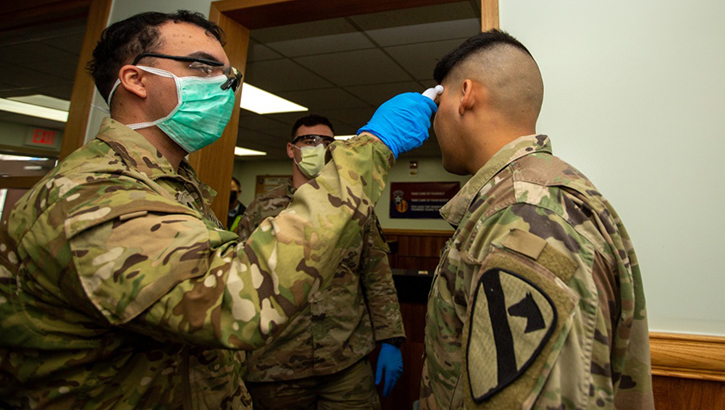
COVID-19: Know what the terms mean

Soldiers stationed on U.S. Army Garrison Casey conduct pre-screening processes on individuals awaiting entry to the base, USAG-Casey, Dongducheon, Republic of Korea, Feb. 26, 2020. Additional screening measures of a verbal questionnaire and temperature check are in response to the heighted awareness of Coronavirus (COVID-19) following a surge in cases throughout the Republic of Korea and are meant to help control the spread of COVID-19 and to protect the force. (U.S. Army photo by Sgt. Amber I. Smith)
With cases of the novel coronavirus, COVID-19, emerging across the globe, governments, organizations, and individuals are taking appropriate steps to protect themselves and others from spreading the respiratory disease that has already infected thousands. Along with increased and enhanced force health protection measures, many people are also learning a new vocabulary that goes along with protecting communities from communicable diseases.
For example, terms frequently used to describe community and self-protection measures include quarantine, isolation, and social distancing. But, what is the difference? According to the Centers for Disease Control and Prevention:
- Quarantine in general means the separation of a person or group of people reasonably believed to have been exposed to a communicable disease but not yet symptomatic, from others who have not been so exposed, to prevent the possible spread of the communicable disease.
- Isolation means the separation of a person or group of people known or reasonably believed to be infected with a communicable disease and potentially infectious from those who are not infected to prevent spread of the communicable disease. Isolation for public health purposes may be voluntary or compelled by federal, state, or local public health order.
- Social distancing means remaining out of congregate settings, avoiding mass gatherings, and maintaining distance (approximately 6 feet or 2 meters) from others when possible.
- Congregate settings are crowded public places where close contact with others may occur, such as shopping centers, movie theaters, stadiums.
- Close contact is defined as:
a) being within approximately 6 feet (2 meters) of a COVID-19 case for a prolonged period of time; close contact can occur while caring for, living with, visiting, or sharing a health care waiting area or room with a COVID-19 case
– or –
b) having direct contact with infectious secretions of a COVID-19 case (e.g., being coughed on).
- Self-observation means people should remain alert for subjective fever, cough, or difficulty breathing. If they feel feverish or develop cough or difficulty breathing during the self-observation period, they should take their temperature, self-isolate, limit contact with others, and seek advice by telephone from a health care provider or their local health department to determine whether medical evaluation is needed.
- Stay at home. This action is further defined as to how an individual will be monitored:
- Self-monitoring means people should monitor themselves for fever by taking their temperature twice a day and remain alert for cough or difficulty breathing. If they feel feverish or develop measured fever, cough, or difficulty breathing during the self-monitoring period, they should self-isolate, limit contact with others, and seek advice by telephone from a health care provider or their local health department to determine whether medical evaluation is needed.
- Self-monitoring with delegated supervision means, for certain occupational groups (e.g., some health care or laboratory personnel, airline crew members), self-monitoring with oversight by the appropriate occupational health or infection control program in coordination with the health department of jurisdiction. The occupational health or infection control personnel for the employing organization should establish points of contact between the organization, the self-monitoring personnel, and the local or state health departments with jurisdiction for the location where personnel will be during the self-monitoring period. This communication should result in agreement on a plan for medical evaluation of personnel who develop fever, cough, or difficulty breathing during the self-monitoring period. The plan should include instructions for notifying occupational health and the local public health authority, and transportation arrangements to a pre-designated hospital, if medically necessary, with advance notice if fever, cough, or difficulty breathing occur. The supervising organization should remain in contact with personnel through the self-monitoring period to oversee self-monitoring activities.
- Self-monitoring with public health supervision means public health authorities assume the responsibility for oversight of self-monitoring for certain groups of people. The ability of jurisdictions to initiate or provide continued oversight will depend on other competing priorities (e.g., contact tracing, implementation of community mitigation strategies). Depending on local priorities, CDC recommends that health departments consider establishing initial communication with these people, provide a plan for self-monitoring and clear instructions for notifying the health department before the person seeks health care if they develop fever, cough, or difficulty breathing. As resources allow, health authorities may also check in intermittently with these people over the course of the self-monitoring period. If travelers for whom public health supervision is recommended are identified at a U.S. port of entry, CDC will notify state and territorial health departments with jurisdiction for the travelers’ final destinations.
- Active monitoring means that the state or local public health authority assumes responsibility for establishing regular communication with potentially exposed people to assess for the presence of fever, cough, or difficulty breathing. For people with high-risk exposures, CDC recommends this communication occurs at least once each day. The mode of communication can be determined by the state or local public health authority and may include telephone calls or any electronic or internet-based means of communication.
As a health practitioner or a beneficiary, it’s important to take appropriate steps to protect yourself, your family, and your co-workers. Knowing the difference between isolation, quarantine, and different forms of monitoring can help to stem the spread of any form of infectious disease.
The most up-to-date information regarding COVID-19 can be found on the CDC website.






















.png)











No hay comentarios:
Publicar un comentario